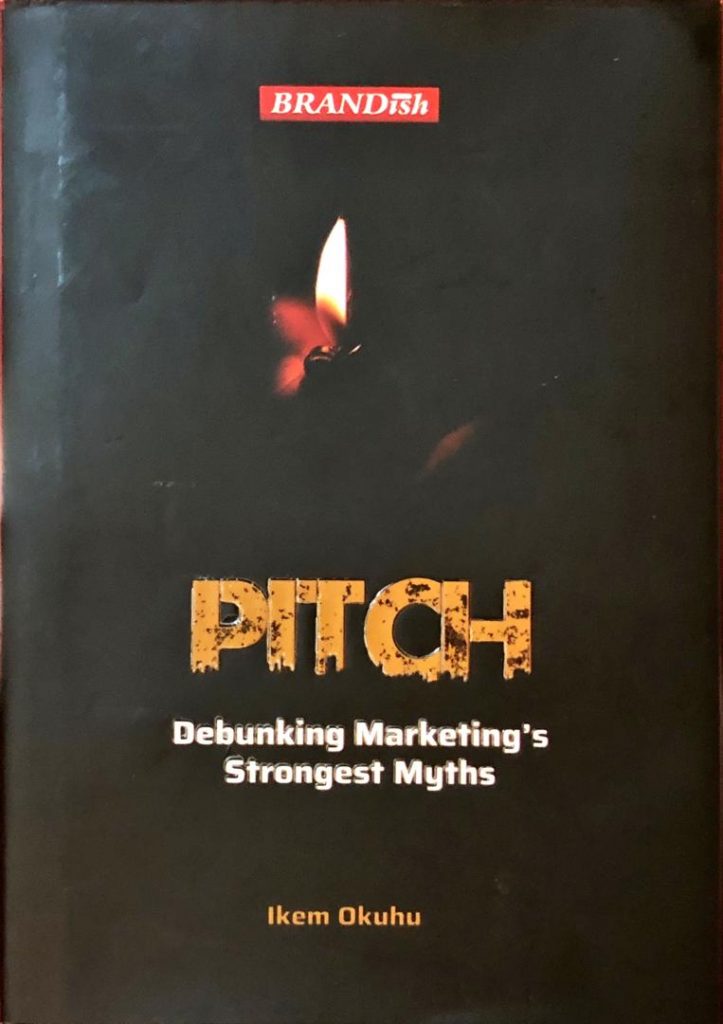Ikem Okuhu (2019), Pitch: Debunking Marketing’s Strongest Myths.
Lagos: Brandish Media. ISBN: 978-978-975-704-6

Pitch: Debunking Marketing’s Strongest Myths entered the market in the
best traditions of marketing communications. The decibel has been loud
and intense, as has been the effort to reach consumers and make them
at least buyers and probably readers of the book. The author of Pitch
demonstrates that you can achieve high levels of awareness and reach
for books in Nigeria bypassing the traditional book distribution channels.
Or almost.
Those building brands deploying public relations with modern platforms
such as Facebook, WhatsApp and Twitter are following the paths of old
masters such as Anita Roddick and her The Bodyshop line that predated
the Internet. The idea was to tell stories around the brand through
various activations including events. The media then reported it.
Since its formal presentation in Lagos, Pitch has grabbed the Facebook
platform and gets a mention every week. It does this deploying Walter
Fischer’s Narrative Paradigm Theory. Narrative Paradigm states that all
meaningful communication is in the form of storytelling. Communication
happens between the narrator and the listener in the form of a story.
Ikem Okuhu has consistently shared a series of stories around Pitch,
from Lagos to Enugu with promises of adding Abuja and other towns.
Friends have shared similar stories of donating the books to university
libraries, mass communication and marketing departments.
Consequently, engaged professionals in integrated marketing
communications in Nigeria have heard of the book. They should, as it
addresses issues within their purview and professional competence.
Pitch is a journalist’s look at various issues in marketing communications
that he feels do not serve the best interests of stakeholders, from
consumers to brand owners and media platforms. He calls them
“marketing’s strongest myths”. Okuhu makes bold assertions and strong
claims.
A central assertion and thesis of the book comes early in the preface.
Okuhu states, “There are far too many things that have been taken for
granted in marketing. Perhaps out of respect for the ‘icons’ of the
industry that laid the foundation for the cultivation of the ideas or merely
because many people find it hard to interrogate certain issues, we have
carried on with a lot that don’t just work. The consequence has been
dire-wasteful marketing spend”.
In 12 chapters across 178 pages, Pitch discusses the marketing role of
the CEO; the “death of advertising”; the significance of mindshare versus
market share; line extensions; and the growing role of technology and
artificial intelligence in marketing. It also treats the role or non-
contribution of innovation, pricing, globalisation and corporate social
responsibility. It examines the matter of nation branding and what it
takes to brand successful nation brands.
An icon of advertising, Mr Lolu Akinwunmi, offers a strong endorsement.
Akinwunmi in the Foreword pats the author on the back with a “well
done”. He observes, “Dwelling mainly on some of the things marketers
hold very dearly and consider sacrosanct, the author offers some new
and potentially controversial perspectives into some of marketing
communication industry’s strongly held views.”
There is much learning in Pitch, particularly for persons coming to
marketing communications anew and students of the discipline. The
material on CEO Types and their impact on the business is very
informative. It draws on the western templates against which Okuhu rails
but offers deep insights into character traits and metrics. He ends it with
a useful guide to CEO positioning and branding.
Chapter 11 on “Every nation is not a brand” illuminates the challenges of
branding Nigeria and some of the reasons why previous efforts failed. It
contains material on the indices for national competitiveness and
comparison of branding efforts by countries such as India. Usually there
is a congruence of the internal and the external with communications
being the culmination of various other efforts.
Pitch offers many mini-cases and narratives of successes and failures in
the marketplace. Narratives include Hero lager beer, Star and its many
line extensions, Guinness Stout, Origin beer, Thermocool, Access Bank
etc. The account of the fate of Heineken Magnum is particularly
instructive as it makes the case for the place of culture in communication
and marketing. The stories however come across as the impressions
and opinions of the author. They would read better, as both journalism
and marketing literature, if there is a balance featuring interactions and
interviews with the brand custodians to explain why and how they took
the decisions they made with actual data on market share and
competition. A revised edition should take care of this.
The controversies will centre around his assertions in chapter three on
mind share versus market share. He mentions the battle of Coca Cola
versus Big Cola, Gala versus Rite Bite and the war of the beer and
detergent brands. In this segment, the author falls into the trap of the
use of unverifiable data of which he accused the industry. He allots
market share of Coca Cola 51%, Pepsi, 41%, Big Cola 4% and Bigi, 1%.
The author credits this data to “Market Intelligence”. The book could do
with better statistics from identifiable and reliable sources.
Line extensions remain controversial in marketing since Ries and Trout
(1972). The chapter on line extensions is hard-hitting. It is a surprise that
since the book hit the market, none of the brands skewered has offered
a rebuttal or an explanation of what happened, why and the learnings.
The chapter raises a significant issue in marketing. Marketing
professionals distinguish between brand extensions, line extensions and
licensed merchandise. According to Mathew Healy (2010), in What is
Branding? brand extensions function vertically; custodians use the same
brand in a new category where the brand’s meaning still makes sense to
customers. Line extensions tend to be horizontal and geared to higher or
lower segments within the same category. Licensed merchandise
applies the brand to an item that may be unrelated to the original brand.
The author of Pitch assumes that the reader is familiar with the pillars of
marketing and its myths and does not bother to explain them for context
before busting them. Marketing revolves around these pillars: attracting
new clients; retaining and growing relationships for the brand and
company; increasing name recognition and awareness; and creating
targeted effective communications using all the tools including
advertising, public relations, trade promotion, sponsorships and social
media as well as community involvement.
What are the myths that Pitch then busts? The reader must infer that
they include the primacy of advertising using traditional media; the role
of line extensions; the link between pricing, brand value and customer
acceptance; the role of innovation; the role and limitations of branding,
the place and importance of globalisation and the routes to market.
The assertion that “advertising is dead” should generate a lively debate.
Much advertising features online and social media platforms. So how is
it dead? Is it advertising that died or there is a change in the platforms
for delivering it so much so as to leave the traditional ones lost?
Pitch is a must-have for professionals as well as students in the related
fields of marketing, mass communication and cognate disciplines such
as sociology, economics and psychology. It has started a conversation
that invites the active engagement of the IMC field. How well the industry
responds to the issues the book raises would also be an index of its
health and capacity for intellectual engagement. The nation awaits and
watches.

